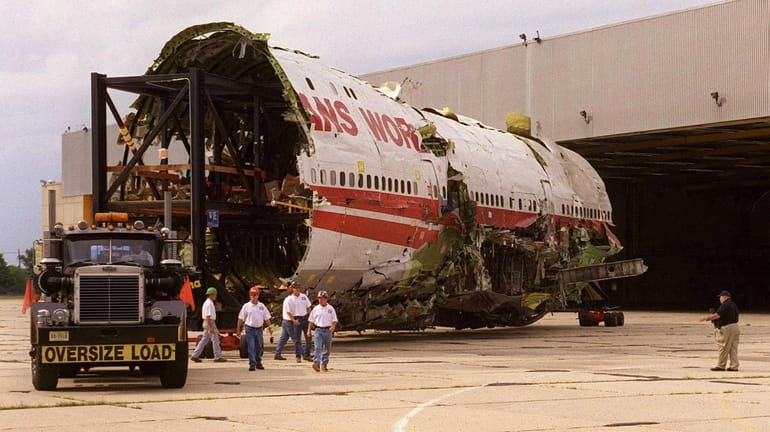Editorial: Flight 800 fixes still needed

A tractor moves the reconstructed wreckage of TWA Flight 800 from the hangar where it was pieced together, to another hangar at the old Grumman plant in Calverton. Credit: Newsday, 1999 / Dick Kraus
It's been 16 years since Paris-bound TWA Flight 800 exploded off Long Island's South Shore moments after taking off from Kennedy Airport. But all these years later, 383 planes built by the Boeing Co. are still flying without the most critical design change the Federal Aviation Administration later mandated to reduce the risk of similar tragedies.
At first blush that seems unconscionable. Sixteen years is a long time to wait when passenger safety is at stake. But the FAA has been diligent in pressing to make what's already an extremely rare catastrophe even less likely.
Its researchers even went to work and invented a device to provide a cost-effective way to finally eliminate the suspected cause of the explosion. And four years ago the FAA directed manufacturers to develop design changes and service instructions for installing the new technology in their planes so tragedies like the one that claimed 230 lives in 1996 could be averted. Now the FAA has to make sure the affected manufacturers and airlines meet its 2017 deadline to retrofit planes still in service with the new system.
The FAA gave Boeing an emphatic nudge Friday. It proposed a $13.57-million civil penalty against the company for missing its 2010 deadline to submit service instructions for retrofitting the planes.
Getting to this point wasn't easy. It took years to figure out what caused Flight 800 to explode. Speculation at the time included a bomb or missile strike before officials said the likely cause was an electrical spark that ignited oxygen in the partially empty central fuel tank.
Since then the FAA has required hundreds of changes to eliminate potential ignition sources, such as rerouting wiring near fuel tanks. But officials initially decided that there was no practical way to get the oxygen out of the tanks. Equipment available at the time was too heavy and big for use on commercial aircraft.
That changed when FAA researchers in New Jersey managed to adapt a light and relatively simple medical device to replace the flammable oxygen with inert nitrogen. With that technology in hand, the FAA required that all new planes include the system. And in July 2008 it directed Boeing and Airbus -- manufacturers using central fuel tanks -- to develop systems to install the technology in planes already in service. The mandate covers 2,730 aircraft, about half of the nation's passenger air fleet. The companies were given until Dec. 27, 2010, to develop service instructions for carriers to use in installing the systems, and submit them for FAA approval. Airbus met the deadline. Boeing didn't.
A spokesman said Boeing has included a flammability reduction system in new designs and it has been installed on planes in production. The company's noncompliance involves two model lines -- versions of the 747 and 757 -- that are out of production but still flying. Boeing said it has now submitted service instructions to the FAA. The companies face two additional deadlines. Half of the aircraft are to be retrofitted by 2014 and all of them by 2017. Boeing needs to make sure the 2017 deadline is met.
It's been a long wait, but not one plane has been brought down by a midair fuel-tank explosion since 1996. Officials need to make sure it stays that way.
